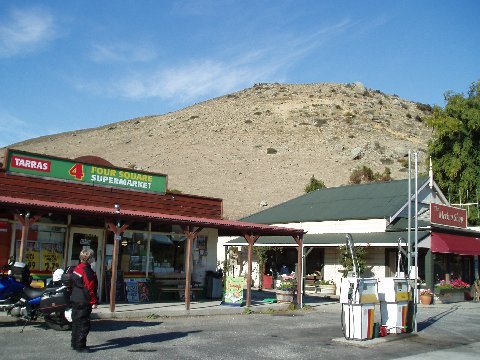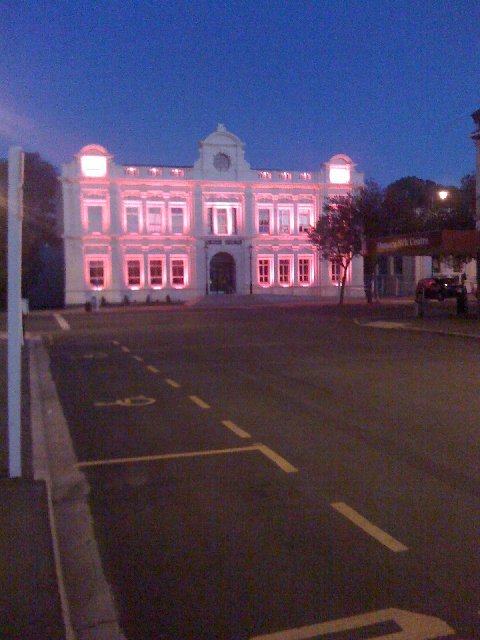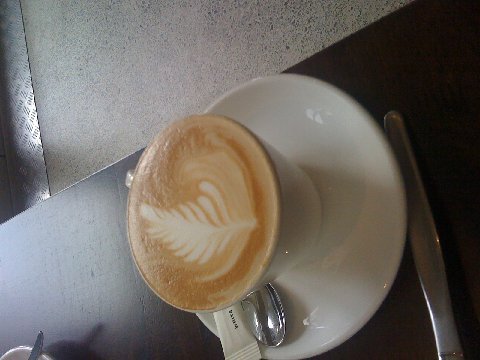End of the Ride
When I got back to town, we wandered off to find dinner. We’d sampled many of the eating establishments there so went in search of one we hadn’t tried. On a back street we found “the White House”, obviously a former residence (once called “the Anchorage” as noted by the embedded shells in the patio) now a restaurant with an eclectic menu featuring local fish, NZ dishes and Mediterranean cuisine. We sat outside in the little courtyard, by ourselves (it was getting cool and the few other diners decided to stay inside by the fire) and had excellent meals and a local wine while the sun went behind the mountains. The restaurant’s black cat came over to investigate us, then wandered back inside. I suppose if everyday life was like this, a person would get used to it and find it routine….but I’m willing to take that risk

(Gas & pastry stop near Lindis Pass)
We finally had to leave Wanaka, reluctantly. We held off until the last minute, then saddled up and went into the mountains headed for the Lindis Pass and then back down to the coast. The Lindis Pass is often described in various writings as “Legendary” and it’s easy to see why. The road climbs from outside Wanaka, rising quickly along the edge of a mountain range so that one can feel the pressure increasing in the inner ear. We can see below us the road from which we came, down in the valley. Soon we’re in a high valley, much like that found in the high desert of eastern Oregon or the dry side of the Cascades.
We’re following the Lindis River through the mountains down to where it is dammed above the coastal plain. There is a brief period of swichbacks as we cross the highest part, then we descend to the town of Omarama, the jumping off point to go up to the backside of Mt. Cook. But we can’t make that diversion today, the leash is tightening, pulling us toward the sea and the end of the trip. We head down the river, ever descending, to Oamaru. As we pass the huge dam and artificial lake there is a thin ribbon of water that has been diverted from the dam to afford irrigation and water control, I assume, that follows the road like a liquid sidewalk.
The road is flatter and straighter now, following the river valley until it finally meets up with Route One and the Pacific Ocean is again in view. It’s but a short jaunt from here back in to Oamaru where we will stay for the night at “41 on Tyne” a small B&B near the Blue Penguin Colony. We’d noticed it the last time we were here, as we walked to the colony, and thought it looked interesting. The “room” there is actually a separate cottage in the steep front yard of the house which sits above it on the hillside. The driveway is quite an incline, not anyplace I’d want to leave the bike for the night, so our host Carola tells me to put the V-Strom in the yard beside the cottage, an area reached only through an opening in the trees, over a small bank. It will be quite safe there…once I get it there. It really isn’t as difficult as it looks and the bike is quite easy to handle once the bags are off, so it goes right where I want it. We’ll worry about getting it back out in the morning! We want to explore this old harbor town again to get a better feel for the limestone buildings and the old wharf area we breezed past last time.

(The Opera House building in Oamaru)

(Brenda & friend in Oamaru)
We walked for about an hour and a half through the streets of Oamaru, including a several block diversion to visit the historical home of native author Janet Frame, who grew up here. Her modest house has been preserved as it probably looked in the 30’s when she lived here from age 7 to 19. We can imagine that the area around it was somewhat different then, the street most likely not paved, the housing not quite as dense in the neighborhood. The town in this part is on hills, reminding us just a bit of parts of San Francisco, but as that town must have looked in its very early days. We walk back down to the town center, crossing the wide main street toward the harbor. We have now learned that the space afforded in the street was not due to extraordinary vision of the future needs, but instead the necessity of room to turn around freight wagons, pulled by teams of 12 bullocks, as they moved cargo from the harborside to the warehouses and mercantile establishments up on the main road. Nonetheless, it certainly gives the town an expansive feel, a look like a place where big things have happened and can happen again.
By now we’re feeling a bit peckish and in need of yet another fine meal….oh, the difficulties of travel in NZ ! We had already selected the Portside Restaurant, where we were going to eat the last time we were here. It was closed then for a holiday, but we now had a second chance. The restaurant juts out into the bay overlooking the seawall and, on one side, the area of the penguins. We ate out on the deck as the sun disappeared over the city behind us. At a nearby table, a young family was eating, with the kids often disappearing down to the waterside to play. One little girl, perhaps 7 years old, came back to the table crying. When her mother asked the reason, she said, in her charming accent, that another child had told her she was “annoying”. Such a civilized epithet for children to use !

(Even a cup of coffee is art in NZ…the silver fern is their national symbol)
We walked back to our lodging, hoping to see a straying penguin, but no such luck tonight.
Our last day on the road, Monday the 30th. We awoke in Oamaru in our “self contained” B&B cottage and availed ourselves of the variety of cereals, coffee & tea there for us. Our host, Roland, arrived at our door with fresh bread he bakes for guests. He and his wife are ex-pat Brits who apparently emigrated to Australia, then on over here to NZ. He was in engineering for a while but now does part time consulting and full-time B&B. In such a nice place, not a bad situation to be in.
The Suzuki came out of its berth quite easily, as I expected, just a bit of care needed with the turn onto the sloping driveway, and I backed it down to the street to accept its burdens for the ride home. We loaded up for the last time and hit the road south, going slower now, trying to drag out the last bits as long as we could. Another stop at Moreaki Point for coffee and view (and to pet “Havoc”, the chocolate lab who belongs to the café . His name is the antithesis of his personality….if only our Malcolm could be so calm !…and he greets each visitor with solemnity, assuring each that if only they will abandon their journey to spend the day petting him, all will be well.) The boulders hadn’t moved any since our last visit.
At Waitaki, we veer off of Rt. One and head over the mountain on what is described as the “bicycle route to Dunedin” that Roland at the B&B had recommended. It turns out to be not exactly my idea of bicycling, since the inclines are steep and very, very long, but the views of the valleys below are amazing. (My friend Gary Griffin would find this to meet exactly his idea of bicycling, by the way.) When we get above Dunedin, the whole city spreads out beneath us, rimming the bay and climbing up the sides of the hills. I can’t look long, since even a short loss of attention to task could have us over the side and provide a very exciting but brief end to the trip. When we finally reach the bottom of the hill, we’re on North Street which I recall is the route to Baldwin Street, billed as the “steepest street in the world”. Anything that is the most of whatever it is “in the world” deserves to be seen, so I sought it out. If it isn’t what it claims, I can’t imagine what would be. I stopped at the bottom, marveling that there were in fact houses arranged up the sides of what had to be nearly a 45-degree slope…or more, it’s hard to tell from down here looking up. There was a single car parked at the top, facing down (I’d hate to think of backing down this hill) and I wondered just how well its owner trusted his emergency brake.
I didn’t go up the hill (partially because Brenda, being sensible, refused to go up with me if I did) because I couldn’t see what was at the top so the thought of turning around a rented bike on such an incline just didn’t seem like a good idea. From there, we headed on down into the center of Dunedin, the city traffic marking a return to the real world we’d avoided for over three weeks. We needed lunch (well, OK, didn’t really need it…I won’t need to eat for at least another month) so we diverted out to Port Chalmers, a small working port town out on the bay, for one last meal on the road. We selected a likely looking café where we ate interesting salads (by that I mean that I’m not really sure what was in them, but it was quite good) out on a little courtyard under trees and pondered the end of the line….and where we’d like to go next.
We returned the bike to the Weir’s home on Maori Hill and unloaded the bags. Howard & Judith weren’t home yet, but they’d left the door open to their loft apartment over the garage where we would stay until the next morning when our flight left for Auckland. When they did return from work (Howard’s a firefighter and Judith’s a teacher) they invited us for dinner to share fresh fish Howard had caught a day or so earlier off the coast. It was yet another grand meal (the best fish I think I’ve ever experienced) and lively conversation with a most interesting couple (them, not us) aided by a bottle of excellent local wine. The Weirs run this motorcycle hire business as an extension of their love for the sport and their marvelous country. Not quite so many riders from our country make it down to Dunedin, here on the south coast of NZ, for independent rides. The majority seem to fly into Auckland (apparently the only direct international flights into Dunedin airport are from Australia) and rent there or take organized tours from there or one of the larger cities in the North. As Howard pointed out, the best motorcycling is to be found on the south island and the population here is one-third of the north island on twice as much space. In my view, the big cities of the north would be a distraction from the ride. It makes more sense, for my kind of trip, to take the short flight from Auckland down here to Dunedin, rent a bike that seems perfect for the conditions here, and start a fantastic ride from the moment one leaves Howard & Judith’s driveway.
Tomorrow it’s back on a plane to Auckland, then a day in the big city, and head for home.